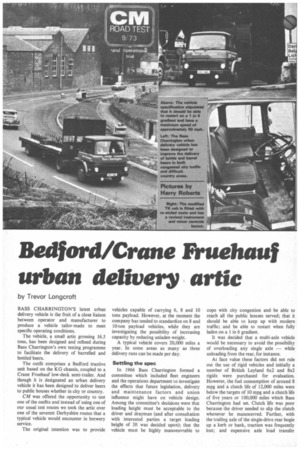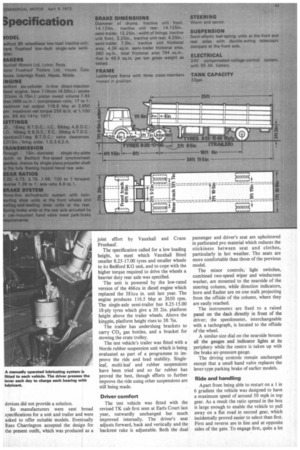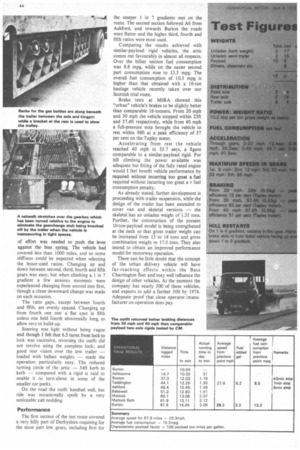Bedford/Crane Fruehauf urban delivery artic
Page 44

Page 45

Page 46

If you've noticed an error in this article please click here to report it so we can fix it.
by Trevor Longcroft BASS CHARRINGTON'S latest urban delivery vehicle is the fruit of a close liaison between operator and manufacturer to produce a vehicle tailor-made to meet specific operating conditions.
The vehicle, a small artic grossing 16.5 tons, has been designed and refined during Bass Charrington's own testing programme to facilitate the delivery of barrelled and bottled beers.
The outfit comprises a Bedford tractive unit based on the KG chassis, coupled to a Crane Fruehauf low-deck semi-trailer. And though it is designated an urban delivery vehicle it has been designed to deliver beers to public houses whether in city or country.
CM was offered the opportunity to test one of the outfits and instead of using one of our usual test routes we took the artic over one of the severest Derbyshire routes that a typical vehicle would encounter in brewery service.
The original intention was to provide vehicles capable of carrying 6, 8 and 10 tons payload. However, at the moment the company has tended to standardize on 8 and 10-ton payload vehicles, while they are investigating the possibility of increasing capacity by reducing unladen weight.
A typical vehicle covers 20,000 miles a year. In some areas as many as three delivery runs can be made per day.
Settling the spec In 1966 Bass Charrington formed a committee which included fleet engineers and the operations department to investigate the effects that future legislation, delivery and maintenance factors and union influence might have on vehicle design. Among the committee's decisions were that loading height must be acceptable to the driver and drayman (and after consultation with interested parties a target loading height of Mt was decided upon); that the vehicle must be highly manoeuvrable to cope with city congestion andbe able to reach all the public houses served; that it should be able to keep up with modern traffic; and be able to restart when fully laden on a 1 in 6 gradient.
It was decided that a multi-axle vehicle would be necessary to avoid the possibility of overloading any single axle -while unloading from the rear, for instance.
At face value these factors did not rule Out the use of rigid vehicles and initially a number of British Leyland 6x2 and 8x2 rigids were purchased for evaluation. However, the fuel consumption of around 8 mpg and a clutch life of 12,000 miles were below the targets of 10 mpg and a clutch life of five years or 100,000 miles which Bass Charrington had set. Clutch life was poor because the driver needed to slip the clutch whenever he manoeuvred. Further, with the trailing axle of the single-drive rear bogie up a kerb or bank, traction was frequently lost; and expensive axle load transfer devices did not provide a solution.
So manufacturers were sent broad specifications for a unit and trailer and were asked to offer suitable models. Eventually Bass Charrington accepted the design for the present outfit, which was produced as a joint effort by Vauxhall and Crane Fruehauf.
The specification called for a low loading height, to meet which Vauxhall fitted smaller 8.25-17.00 tyres and smaller wheels to its Bedford KG unit, and to cope with the higher torque required to drive the wheels a heavier duty rear axle was specified.
The unit is powered by the low-rated version of the 466cu in diesel engine which replaced the 381cu in. unit last year. The engine produces 116.5 bhp at 2650 rpm. The single-axle semi-trailer has 8.25-15.00 18-ply tyres which give a 3ft 2in. platform height above the trailer wheels. Above the kingpin, platform height rises to 3ft 7in.
The trailer has underslung brackets to carry CO2 gas bottles, and a bracket for stowing the crate trolley.
The test vehicle's trailer was fitted with a Norde rubber suspension unit which is being evaluated as part of a programme to improve the ride and load stability. Singleleaf, multi-leaf and rubber suspensions have been tried and so far rubber has proved the best, though efforts to further improve the ride using other suspensions are still being made.
Driver comfort The test vehicle was fitted with the revised TK cab first seen at Earls Court last year, outwardly unchanged but much improved internally. The driver's seat adjusts forward, back and vertically and the backrest rake is adjustable. Both the dual passenger and driver's seat are upholstered in perforated pvc material which reduces the stickiness between seat and clothes, particularly in hot weather. The seats are more comfortable than those of the previous model.
The minor controls,' light switches, combined two-speed wiper and windscreen washer, are mounted to the nearside of the steering column, while direction indicators, horn and flasher are on one stalk projecting from the offside of the column, where they are easily reached.
The instruments are fixed to a raised panel on the dash directly in front of the driver; the speedometer, interchangeable with a tachograph, is located to the offside of the wheel.
A similar-size dial on the nearside houses all the gauges and indicator lights at its periphery while the centre is taken up with the brake air-pressure gauge.
The driving controls remain unchanged except that a small hand valve replaces the lever-type parking brake of earlier models.
Ride and handling
Apart from being able to restart on a 1 in 6 gradient the vehicle was designed to have a maximum speed of around 50 mph in top gear. As a result the ratio spread in the box is large enough to enable the vehicle to pull away on a flat road in second gear, which incidentally proved easier to select than first. First and reverse are in line and at opposite sides of the gate. To engage first, quite a lot of effort was needed to push the lever against the bias spring. The vehicle had covered less than 1000 mites, and so some stiffness could be expected when selecting the lesser-used ratios. Changing up and down between second, third, fourth and fifth gears was easy, but when climbing a I in 7 gradient a few anxious moments were experienced changing from second into first, though a clean downward change was made on each occasion.
The ratio gaps, except between fourth and fifth, are evenly spaced. Changing up from fourth one met a flat spot in fifth unless one held fourth abnormally long, to allow revs to build-up.
Steering was light without being vague and though I felt that 6.5 turns from lock to lock was excessive, reversing the outfit did not involve using the complete lock; and good rear vision over the low trailer loaded with ballast weights made the operation particularly easy. The reduced turning circle of the artic 34ft kerb to kerb compared with a rigid is said to enable it to turn-about in some of the smaller car parks.
On the road the outfit handled well, but ride was occasionally spoilt by a very noticeable cab nodding.
Performance The first section of the test route covered a very hilly part of Derbyshire requiring for the most part low gears, including first for
the steeper 1 in 7 gradients met on the route. The second section followed A6 from Ashford, and towards Burton the roads were flatter and the higher third, fourth and fifth ratios were most used.
Comparing the results achieved with similar-payload rigid vehicles, the artic comes out favourably in almost all respects. Over the hillier section fuel consumption was 8.8 mpg, while on the easier second part consumption rose to 13.3 mpg. The overall fuel consumption of 10.3 mpg is higher than that obtained with a 16-ton haulage vehicle recently taken over our Scottish trial route.
Brake tests at MIRA showed this "urban" vehicle's brakes to be slightly better than comparable 16-tonners. From 20 mph and 30 mph the vehicle stopped within 2511 and 57.4ft respectively, while from 40 mph a full-pressure stop brought the vehicle to rest within 98ft at a peak efficiency of 57 per cent on the Tapley meter.
Accelerating from rest the vehicle reached 40 mph in 55.7 secs, a figure comparable to a similar-payload rigid. For hill climbing the power available was adequate but fitting of the fully rated engine would I feel benefit vehicle performance by required without incurring too great a fuel required without incurring too great a v fuel consumption penalty.
As already stated, further development is proceeding with trailer suspension, while the design of the trailer has been extended to cover van and skeletal versions the skeletal has an unladen weight of 1.35 tons. Further, the construction of the present I0-ton-payload model is being strengthened at the neck so that gross trailer weight can be increased from 13 to 14 tons and gross combination weight to 17.5 tons. They also intend to obtain an improved performance model for motorway, operation.
There can be little doubt that the concept of the urban delivery vehicle will have far-reaching effects within the Bass Charrington fleet and May well influence the design of other vehicles. At the moment the company has nearly 300 of these vehicles, and expects to add a further 500 by 1974. Adequate proof that close operator/manufacturer co-operation does pay.












































































































